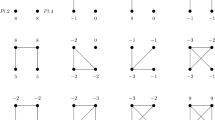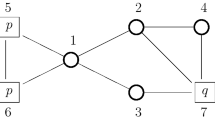Abstract
We propose the notion of myopic-farsighted absorbing set to determine the networks that emerge in the long run when some players are myopic while others are farsighted. A set of networks is a myopic-farsighted absorbing set if (No External Deviation) there is no myopic-farsighted improving path from networks within the set to some networks outside the set, (External Stability) there is a myopic-farsighted improving path from any network outside the set to some network within the set, and (Minimality) there is no proper subset satisfying No External Deviation and External Stability. Contrary to the notion of myopic-farsighted stable set, we show that a myopic-farsighted absorbing set always exists. We partially characterize the myopic-farsighted absorbing sets and we provide sufficient conditions for the equivalence between a myopic-farsighted absorbing set and a myopic-farsighted stable set. We also introduce and fully characterize the notion of proper myopic-farsighted absorbing set that refines the concept of myopic-farsighted absorbing set by selecting the more absorbing networks. Finally, we consider a threshold game that illustrates the role of the relative number of farsighted and myopic players for reaching efficiency.




Similar content being viewed by others
Notes
Mauleon and Vannetelbosch (2016) provide a comprehensive overview of the solution concepts for solving network formation games.
Throughout the paper we use the notation \(\subseteq \) for weak inclusion and \(\varsubsetneq \) for strict inclusion. Finally, \(\#\) will refer to the notion of cardinality.
Page and Wooders (2009) define a basin of attraction as a set of networks to which the network formation process might tend and from which there is no escape.
The pairwise CP vNM set follows the approach by Page and Wooders (2009) who define the stable set with respect to path dominance, i.e., the transitive closure of \(\phi \).
Luo et al. (2021) provide conditions on the utility function that guarantee the existence and uniqueness of a myopic-farsighted stable set.
References
Chwe, M. S. (1994). Farsighted coalitional stability. Journal of Economic Theory, 63, 299–325.
Diamantoudi, E., & Xue, L. (2003). Farsighted stability in hedonic games. Social Choice and Welfare, 21, 39–61.
Dutta, B., Ghosal, S., & Ray, R. (2005). Farsighted network formation. Journal of Economic Theory, 122, 143–164.
Dutta, B., & Vohra, R. (2017). Rational expectations and farsighted stability. Theoretical Economics, 12, 1191–1227.
Herings, P. J. J., Mauleon, A., & Vannetelbosch, V. (2004). Rationalizability for social environments. Games and Economic Behavior, 49, 135–156.
Herings, P. J. J., Mauleon, A., & Vannetelbosch, V. (2009). Farsightedly stable networks. Games and Economic Behavior, 67, 526–541.
Herings, P. J. J., Mauleon, A., & Vannetelbosch, V. (2017). Stable sets in matching problems with coalitional sovereignty and path dominance. Journal of Mathematical Economics, 71, 14–19.
Herings, P. J. J., Mauleon, A., & Vannetelbosch, V. (2019). Stability of networks under horizon-\(K\) farsightedness. Economic Theory, 68, 177–200.
Herings, P. J. J., Mauleon, A., & Vannetelbosch, V. (2020). Matching with myopic and farsighted players. Journal of Economic Theory, 190, 105125.
Jackson, M. O. (2008). Social and economic networks. Princeton, NJ, USA: Princeton University Press.
Jackson, M. O., & Watts, A. (2002). The evolution of social and economic networks. Journal of Economic Theory, 106, 265–295.
Jackson, M. O., & Wolinsky, A. (1996). A strategic model of social and economic networks. Journal of Economic Theory, 71, 44–74.
Kirchsteiger, G., Mantovani, M., Mauleon, A., & Vannetelbosch, V. (2016). Limited farsightedness in network formation. Journal of Economic Behavior and Organization, 128, 97–120.
Luo, C., Mauleon, A., & Vannetelbosch, V. (2021). Network formation with myopic and farsighted players. Economic Theory, 71, 1283–1317.
Mauleon, A., Sempere-Monerris, J.J., & Vannetelbosch, V. (2018). R&D network formation with myopic and farsighted firms. CORE Discussion Paper 2018-26, UCLouvain.
Mauleon, A., & Vannetelbosch, V. (2004). Farsightedness and cautiousness in coalition formation games with positive spillovers. Theory and Decision, 56, 291–324.
Mauleon, A., & Vannetelbosch, V. (2016). Network formation games. In Y. Bramoullé, A. Galeotti, & B. W. Rogers (Eds.), The Oxford Handbook of The Economics of Networks. UK: Oxford University Press.
Page, F. H., Jr., & Wooders, M. (2009). Strategic basins of attraction, the path dominance core, and network formation games. Games and Economic Behavior, 66, 462–487.
Page, F. H., Jr., Wooders, M., & Kamat, S. (2005). Networks and farsighted stability. Journal of Economic Theory, 120, 257–269.
Ray, D., & Vohra, R. (2015). The farsighted stable set. Econometrica, 83(3), 977–1011.
Ray, D., & Vohra, R. (2019). Maximality in the farsighted stable set. Econometrica, 87(5), 1763–1779.
Tercieux, O., & Vannetelbosch, V. (2006). A characterization of stochastically stable networks. International Journal of Game Theory, 34, 351–369.
Teteryatnikova, M., & Tremewan, J. (2020). Myopic and farsighted stability in network formation games: an experimental study. Economic Theory, 69, 987–1021.
Xue, L. (1998). Coalitional stability under perfect foresight. Economic Theory, 11, 603–627.
Acknowledgements
Ana Mauleon and Vincent Vannetelbosch are, respectively, Research Director and Senior Research Associate of the National Fund for Scientific Research (FNRS). Financial support from the Fonds de la Recherche Scientifique - FNRS research grant T.0143.18 is gratefully acknowledged.
Author information
Authors and Affiliations
Corresponding author
Additional information
Publisher's Note
Springer Nature remains neutral with regard to jurisdictional claims in published maps and institutional affiliations.
Rights and permissions
About this article
Cite this article
de Callataÿ, P., Mauleon, A. & Vannetelbosch, V. Myopic-farsighted absorbing networks. Theory Decis 94, 405–422 (2023). https://doi.org/10.1007/s11238-022-09895-8
Accepted:
Published:
Issue Date:
DOI: https://doi.org/10.1007/s11238-022-09895-8




